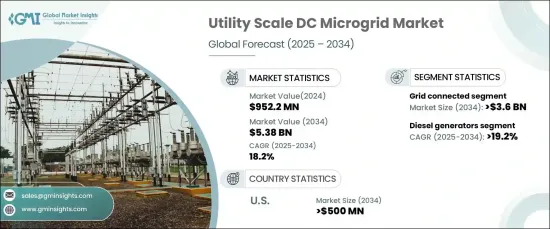
|
시장보고서
상품코드
1665284
유틸리티 규모 DC 마이크로그리드 시장 : 시장 기회, 성장 촉진요인, 산업 동향 분석, 예측(2025-2034년)Utility Scale DC Microgrid Market Opportunity, Growth Drivers, Industry Trend Analysis, and Forecast 2025 - 2034 |
||||||
세계의 유틸리티 규모 DC 마이크로그리드 시장은 2024년에는 9억 5,220만 달러에 이르렀고, 2025년부터 2034년까지 18.2%의 경이적인 CAGR로 성장할 것으로 예측되고 있습니다. 이러한 첨단 마이크로그리드는 직류(DC) 전력을 발전, 분배, 활용하도록 설계된 국소 에너지 시스템으로 그리드의 신뢰성을 높이고 탈탄소화를 촉진합니다. 분산 에너지 자원(DER)을 통합하기 위한 유연한 솔루션을 제공하고, 원활한 배전을 위한 그리드 연계 모드에서도, 정전 시의 섬초 모드에서도 동작해, 중요한 업무나 원격지에의 지속적인 전력 공급을 보증합니다.

태양광 발전(PV)과 풍력 발전과 같은 신재생 에너지를 쉽게 통합할 수 있는 효율적인 에너지 시스템에 대한 수요 증가가 DC 마이크로그리드의 채용 확대를 뒷받침하고 있습니다. 전력 회사가 신재생 에너지 통합을 최적화하기 위해 DC 마이크로그리드는 분산 에너지 시스템 관리에 필수적인 도구가 되고 있습니다. 국부적인 발전, 저장 및 소비를 지원하는 능력은 현대 에너지 네트워크에 이상적입니다. 분산 시스템으로의 급속한 시프트는 DC 마이크로그리드의 채택을 더욱 가속화하고, 유틸리티 기업이 DER을 보다 효과적으로 관리하면서 전반적인 에너지 유연성과 효율성을 높일 수 있게 합니다.
| 시장 범위 | |
|---|---|
| 시작 연도 | 2024년 |
| 예측 연도 | 2025-2034년 |
| 시작 금액 | 9억 5,220만 달러 |
| 예측 금액 | 53억 8,000만 달러 |
| CAGR | 18.2% |
그리드 연계형은 그리드 연계 모드와 아일랜드 모드 사이를 원활하게 이행할 수 있기 때문에 2034년까지 360만 달러의 매출이 전망되고 있습니다. 이 기능은 시스템의 신뢰성을 높이고 전력 중단을 최소화하기 때문에 매우 매력적입니다. 확장 가능하고 비용 효율적인 솔루션에 대한 수요가 증가함에 따라 이러한 마이크로그리드는 대규모 인프라 업그레이드를 필요로 하지 않고 점진적으로 용량을 확장 할 수 있다는 점에서 지지를 얻고 있습니다. 에너지 효율 개선과 운영 비용 절감은 미래의 에너지 상황을 지원하는 마이크로그리드의 역할을 더욱 견고하게 만듭니다.
전원의 경우 디젤 발전기 부문은 2034년까지 19.2%의 연평균 복합 성장률(CAGR)로 견조하게 성장할 것으로 보입니다. 디젤 발전기는 특히 필수적인 유틸리티 기능을 유지하기 위해 빠르고 안정적인 에너지를 제공하는 데 매우 중요합니다. 인프라를 크게 변경하지 않고 다양한 에너지 수요에 대응할 수 있는 유연성이 채용 증가의 원동력이 되고 있습니다. 이러한 발전기는 그리드 연결이 신뢰할 수 없거나 존재하지 않는 원격지에서도 귀중한 존재임을 입증하여 시장에서의 입지를 더욱 강화하고 있습니다.
미국의 유틸리티 규모 DC 마이크로그리드 시장은 2034년까지 5억 달러를 창출할 것으로 예상됩니다. 이 나라에서는 신재생 에너지의 통합과 탈탄소화 목표에 대한 주목이 높아지고 있으며, 특히 전력 회사가 신재생 에너지원의 변동이 초래하는 과제에 임하고 있는 가운데 수요에 박차를 가하고 있습니다. 자연재해나 송전망의 고장이 빈발하고 있기 때문에 재해에 강한 에너지 솔루션의 필요성이 높아지고 있으며, DC 마이크로그리드는 신뢰성 높은 전력 공급을 확보하는데 있어서 중요한 역할을 담당하고 있습니다. 신재생 기술과 송전망의 현대화에 대한 노력이 진행되고 있는 가운데 미국 시장의 지속적인 성장 전망은 여전히 강합니다.
목차
제1장 조사 방법 및 조사 범위
- 조사 디자인
- 기본 추정 및 계산
- 예측 모델
- 1차 조사 및 검증
- 1차 정보
- 데이터 마이닝 소스
- 시장 정의
제2장 주요 요약
제3장 산업 인사이트
- 산업 생태계
- 규제 상황
- 산업에 미치는 영향요인
- 성장 촉진요인
- 산업의 잠재적 리스크 및 과제
- 성장 가능성 분석
- Porter's Five Forces 분석
- 공급기업의 협상력
- 구매자의 협상력
- 신규 참가업체의 위협
- 대체품의 위협
- PESTEL 분석
제4장 경쟁 구도
- 서문
- 전략 대시보드
- 혁신 및 지속가능성의 전망
제5장 시장 규모 및 예측 : 접속성별(2021-2034년)
- 주요 동향
- 그리드 연결
- 오프 그리드
제6장 시장 규모 및 예측 : 전원별(2021-2034년)
- 주요 동향
- 디젤 발전기
- 천연가스
- 태양광 발전
- CHP
- 기타
제7장 시장 규모 및 예측 : 축전 디바이스별(2021-2034년)
- 주요 동향
- 리튬 이온
- 납축전지
- 플로우 배터리
- 플라이휠
- 기타
제8장 시장 규모 및 예측 : 지역별(2021-2034년)
- 주요 동향
- 북미
- 미국
- 캐나다
- 멕시코
- 유럽
- 독일
- 프랑스
- 영국
- 러시아
- 아시아태평양
- 중국
- 일본
- 한국
- 인도
- 호주
- 중동 및 아프리카
- 사우디아라비아
- 아랍에미리트(UAE)
- 남아프리카
- 라틴아메리카
- 브라질
- 아르헨티나
- 칠레
제9장 기업 프로파일
- ARDA Power
- AEG International
- Bosch Global
- Eaton
- G&W Electric
- PowerSecure
- Sumitomo Electric Industries
- Schneider Electric
- SolarWorX
- Schaltbau Group
The Global Utility Scale DC Microgrid Market is projected to reach USD 952.2 million in 2024 and grow at an impressive CAGR of 18.2% from 2025 to 2034. These advanced microgrids are localized energy systems designed to generate, distribute, and utilize direct current (DC) electricity, enhancing grid reliability and promoting decarbonization. They offer flexible solutions for integrating distributed energy resources (DERs), operating in either grid-connected mode for seamless distribution or islanded mode during outages, ensuring continuous power supply to critical operations and remote areas.

The rising demand for efficient energy systems that can easily integrate renewable sources like solar photovoltaic (PV) and wind energy is driving the growing adoption of DC microgrids. As utilities work to optimize renewable energy integration, DC microgrids are becoming essential tools for managing decentralized energy systems. Their capacity to support localized generation, storage, and consumption makes them ideal for modern energy networks. The rapid shift towards decentralized systems is further accelerating the adoption of DC microgrids, allowing utilities to manage DERs more effectively while enhancing overall energy flexibility and efficiency.
| Market Scope | |
|---|---|
| Start Year | 2024 |
| Forecast Year | 2025-2034 |
| Start Value | $952.2 Million |
| Forecast Value | $5.38 Billion |
| CAGR | 18.2% |
The grid-connected segment is expected to generate USD 3.6 million by 2034, driven by its ability to transition smoothly between grid-connected and islanded modes. This feature enhances system reliability and minimizes power disruptions, making it highly appealing. As the demand for scalable and cost-effective solutions grows, these microgrids are gaining traction for their ability to expand capacity incrementally without the need for extensive infrastructure upgrades. The improved energy efficiency and lower operating costs further solidify their role in supporting the future energy landscape.
Regarding power sources, the diesel generator segment is set to grow at a robust CAGR of 19.2% through 2034. Diesel generators are crucial for providing rapid, reliable energy, especially in maintaining essential utility functions. Their flexibility to meet varying energy demands without significant infrastructure changes is driving increased adoption. These generators are also proving invaluable in remote areas with unreliable or nonexistent grid connections, further strengthening their position in the market.
In the U.S., the utility-scale DC microgrid market is expected to generate USD 500 million by 2034. The country's increasing focus on renewable energy integration and decarbonization goals is spurring demand, particularly as utilities address the challenges posed by the variability of renewable energy sources. The growing frequency of natural disasters and grid failures is highlighting the need for resilient energy solutions, positioning DC microgrids as a key player in ensuring a reliable power supply. With ongoing advancements in renewable technologies and grid modernization efforts, the prospects for continued growth in the U.S. market remain strong.
Table of Contents
Chapter 1 Methodology & Scope
- 1.1 Research design
- 1.2 Base estimates & calculations
- 1.3 Forecast model
- 1.4 Primary research & validation
- 1.4.1 Primary sources
- 1.4.2 Data mining sources
- 1.5 Market definitions
Chapter 2 Executive Summary
- 2.1 Industry synopsis, 2021 – 2034
Chapter 3 Industry Insights
- 3.1 Industry ecosystem
- 3.2 Regulatory landscape
- 3.3 Industry impact forces
- 3.3.1 Growth drivers
- 3.3.2 Industry pitfalls & challenges
- 3.4 Growth potential analysis
- 3.5 Porter's analysis
- 3.5.1 Bargaining power of suppliers
- 3.5.2 Bargaining power of buyers
- 3.5.3 Threat of new entrants
- 3.5.4 Threat of substitutes
- 3.6 PESTEL analysis
Chapter 4 Competitive landscape, 2024
- 4.1 Introduction
- 4.2 Strategic dashboard
- 4.3 Innovation & sustainability landscape
Chapter 5 Market Size and Forecast, By Connectivity, 2021 – 2034 (USD Million & MW)
- 5.1 Key trends
- 5.2 Grid connected
- 5.3 Off grid
Chapter 6 Market Size and Forecast, By Power Source, 2021 – 2034 (USD Million & MW)
- 6.1 Key trends
- 6.2 Diesel generators
- 6.3 Natural gas
- 6.4 Solar PV
- 6.5 CHP
- 6.6 Others
Chapter 7 Market Size and Forecast, By Storage Device, 2021 – 2034 (USD Million & MW)
- 7.1 Key trends
- 7.2 Lithium-ion
- 7.3 Lead acid
- 7.4 Flow battery
- 7.5 Flywheels
- 7.6 Others
Chapter 8 Market Size and Forecast, By Region, 2021 – 2034 (USD Million & MW)
- 8.1 Key trends
- 8.2 North America
- 8.2.1 U.S.
- 8.2.2 Canada
- 8.2.3 Mexico
- 8.3 Europe
- 8.3.1 Germany
- 8.3.2 France
- 8.3.3 UK
- 8.3.4 Russia
- 8.4 Asia Pacific
- 8.4.1 China
- 8.4.2 Japan
- 8.4.3 South Korea
- 8.4.4 India
- 8.4.5 Australia
- 8.5 Middle East and Africa
- 8.5.1 Saudi Arabia
- 8.5.2 UAE
- 8.5.3 South Africa
- 8.6 Latin America
- 8.6.1 Brazil
- 8.6.2 Argentina
- 8.6.3 Chile
Chapter 9 Company Profiles
- 9.1 ARDA Power
- 9.2 AEG International
- 9.3 Bosch Global
- 9.4 Eaton
- 9.5 G&W Electric
- 9.6 PowerSecure
- 9.7 Sumitomo Electric Industries
- 9.8 Schneider Electric
- 9.9 SolarWorX
- 9.10 Schaltbau Group



















